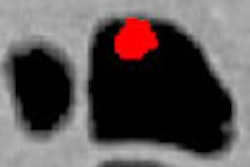Researchers at the University of North Carolina (UNC) in Chapel Hill have adapted telecommunications technology for medical imaging, a marriage that could potentially ramp up CT scanner speed without compromising imaging quality or radiation dose.
Of course, modern clinical CT scanners currently collect more than 1,000 images in less than one second, acknowledged Jian Zhang, Ph.D., in a presentation at the 2007 American Association of Physicists in Medicine (AAPM) meeting in Minneapolis, but speed is limited by the serial collection of data. Zhang is with the university's department of radiation oncology.
The multiplexing technique, already available in cellular phones and high-density magnetic and optical recording, simultaneously collects multiple projection images, Zhang said. Employing carbon nanotubes, the pixilated multibeam-field-emission x-ray source generates both temporally and spatially modulated x-ray beams, which can be gated, to account for bodily movement, and synchronized with physiological signals.
The multiplexing process involves combining multiple signals to form one composite signal for transmission. In a multiplexing CT scanner, multiple x-ray sources fire simultaneously to capture images from multiple views at the same time.
"The speed of clinical CT scanners that can acquire about 1,000 views per gantry rotation could be increased by a factor of 500," Zhang said. "At the same time, the total imaging time and x-ray dose are kept the same as used in the sequential process, then the x-ray power -- the tube current -- can be reduced by a factor of N/2 by multiplexing because the exposure time per image is now longer."
During the multiplexing imaging process, all the x-ray pixels turn on simultaneously with each beam modulated at a different frequency. The superimposed x-ray signals are captured by an x-ray detector, then demultiplexed to recover the original nine projection images from different angles.
"A drastic increase of the speed and reduction of the x-ray peak power are achieved without compromising the imaging quality," he explained.
AAPM meeting attendees asked about the potential increase of scattered radiation that might be generated due to multiple x-ray pixels. Zhang acceded that scattering does increase with multiplexing, but that it can be separated in the process.
This ultrafast CT scanner uses nanotubes as its x-ray source. Zhang is part of a team of physicists at UNC Chapel Hill led by Otto Zhou, Ph.D. In 2000, Zhou filed a patent application for using nanotubes as an x-ray source and co-founded Xintek, which develops the nanotube technology for commercial use.
The team also developed a prototype multipixel CT scanner in 2005. The machine did not require mechanical motion but instead switched rapidly among many x-ray sources, each taking an image of the object from a different angle in fast succession. The next step was to combine the multipixel scanner with multiplexing techniques.
"We recently created a 25-pixel multiplexing CT scanner, but engineering difficulties lie in front of the ultimate goal, a scanner with approximately 1,000 x-ray pixels," Zhang said.
By Kathlyn Stone
AuntMinnie.com contributing writer
October 1, 2007
Related Reading
Germany worried about excess use of CT scans, July 12, 2007
Dual-source CT offers equivalent or lower dose compared to 64-slice, April 26, 2007
Copyright © 2007 AuntMinnie.com




















